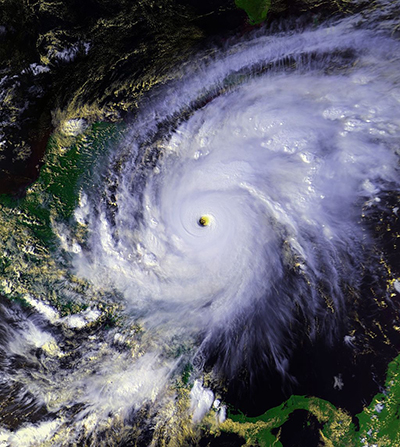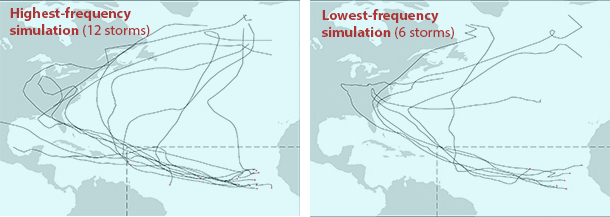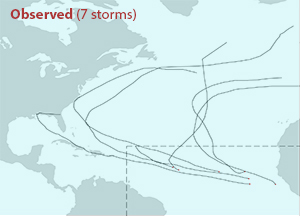Nature's roadblock to hurricane prediction
Experiment shows how small-scale variability can thwart seasonal outlooks
Jul 22, 2014 - by Staff
Jul 22, 2014 - by Staff
July 23, 2014 | The quiet Atlantic hurricane season of 2013 came as a surprise to many, as seasonal forecasts had consistently predicted an unusually large crop of named storms. A new study by scientists at NCAR and North-West University (South Africa) finds that internal variability—processes that unfold without being dictated by larger-scale features—can make one season twice as active as another, even when El Niño and other large-scale hurricane-shaping elements are unchanged. The results suggest that seasonal hurricane forecasts could be improved by conveying the amount of unavoidable uncertainty in the outlook.
Led by NCAR’s James Done, the study focused on the busy 1998 Atlantic season, which produced 14 tropical storms (10 of which became hurricanes). Half of the 14 named storms took shape over the deep North Atlantic tropics, the area south of about 23°N and east of 65°W. About 85% of major hurricanes originate from tropical waves that move off Africa into this region.

Hurricane Mitch, the strongest storm observed in 1998, is the second deadliest Atlantic hurricane on record. Mitch caused more than 10,000 deaths, mainly due to torrential rainfall across Central America. (Wikimedia Commons/NOAA satellite image.)
The study team recreated the 1998 season multiple times using an NCAR-based version of the Weather Research and Forecasting model (WRF). They incorporated the role of internal variability by introducing minor variations in the atmosphere, too small for seasonal forecast models to capture, at the beginning of each model run. This resulted in 16 simulations that had different but equally likely atmospheric features at the start of the key study period (May 1). Ocean temperatures were identical through the season in all simulations.
Despite the similarity of their starting points, the 16 model runs produced strikingly varied results for the season. The total number of named storms in the deep North Atlantic tropics varied from as few as 6 to as many as 12, depending on the simulation. In the actual 1998 season, a total of 7 named storms formed in that region.
Most of the internal variability produced in the simulations was found in two stages of hurricane formation. At the very earliest point, showers and thunderstorms congeal into a tropical wave. At a later point, a fully developed tropical low with warm, moist air at its core goes on to intensify into a tropical storm. At both of these stages, small-scale features such as a blossoming cluster of thunderstorms or a pocket of strong upper-level wind can either nurture or crimp a potential hurricane. The specific timing, locations, and magnitudes of these small-scale features are dependent on internal processes of the climate system and thus cannot be known in advance of the season.
The study did not examine variations in El Niño and La Niña, which are among the main factors used in seasonal hurricane prediction. It’s well established that El Niño years tend to produce fewer Atlantic hurricanes than average, while La Niña years tend to produce more than average.
Although El Niño/La Niña conditions do help in seasonal forecasting, the new study implies that internal variability needs to be considered as well. Over a recent 30-year period (1981-2010), the number of named storms in the study area was as low as 0 and as high as 10 from season to season. However, natural variability alone produced a range of storm counts as low as 6 and as high as 12 in the study’s reproductions of the 1998 season. Thus, natural variability adds a significant component of uncertainty to seasonal forecasts.
“Due to the inherent natural variability, it appears there is an upper limit on how well we can predict hurricane frequency in advance of a season,” Done said. With more research, he added, it’s possible that tools that explicitly include the amount of natural uncertainty could be developed for use in seasonal hurricane prediction. This would help give stakeholders and the public a better idea of each outlook’s margin of error.
Done, J. M., C. L. Bruyère, M. Ge, and A. Jaye (2014), Internal variability of North Atlantic tropical cyclones, Journal of Geophysical Research: Atmospheres 119, 6506–6519 DOI: 10.1002/2014JD021542
|
Writer/contact Principal investigators |
Funders |
 |
 |
While the 1998 hurricane season produced a total of 7 named storms that originated in the deep Atlantic tropics (bottom image), a set of 16 model-based simulations of the season resulted in as few as 6 and as many as 12 storms originating in the same region (top images). Larger-scale features and ocean conditions did not vary among the 16 simulations; the only difference among them was internal variability, or small-scale features that are not dictated by the larger-scale features and thus cannot be foreseen at the start of the hurricane season. (Images courtesy Ming Ge, NCAR.) |